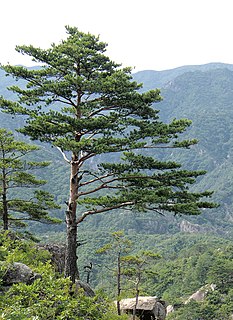
Arkhangelsk Oblast is a federal subject of Russia. It includes the Arctic archipelagos of Franz Josef Land and Novaya Zemlya, as well as the Solovetsky Islands in the White Sea. Arkhangelsk Oblast also has administrative jurisdiction over Nenets Autonomous Okrug. Including Nenetsia, Arkhangelsk Oblast has an area of 587,400 km2. Its population was 1,227,626 as of the 2010 Census.

The Valdai Hills are an upland region in the north-west of central Russia running north-south, about midway between Saint Petersburg and Moscow, spanning Leningrad, Novgorod, Tver, Pskov, and Smolensk Oblasts.
Protected areas of Russia,, is governed by the corresponding 1995 law of the Russian Federation.

Vodlozersky National Park is a national park in the north of Russia, located in Onezhsky District of Arkhangelsk Oblast and Pudozhsky District in the Republic of Karelia. It was established April 20, 1991. Since 2001, the National Park has the status of a UNESCO Biosphere Reserve. The national park was created to protect coniferous forests (taiga) of the Northern Russia.
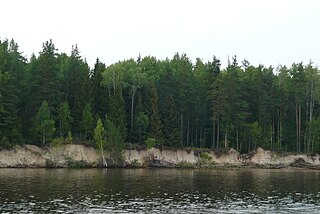
The Nizhnesvirsky Nature Reserve is a 416 km² zapovednik in Lodeynopolsky District of Leningrad Oblast, Russia, established on June 11, 1980 to protect landscapes of the eastern shore of Lake Ladoga.
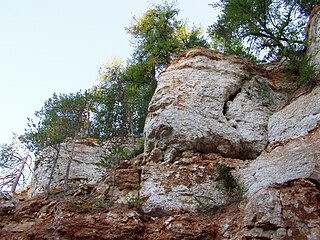
Pinezhsky District is an administrative district (raion), one of the twenty-one in Arkhangelsk Oblast, Russia. Municipally, it is incorporated as Pinezhsky Municipal District. It is located in the northeast of the oblast and borders with Mezensky District in the north, Leshukonsky District and Udorsky District of the Komi Republic in the east, Verkhnetoyemsky District in the south, Vinogradovsky District in the southwest, Kholmogorsky District in the west, and with Primorsky District in the northwest. Its administrative center is the rural locality of Karpogory. District's population: 26,978 (2010 Census); 33,516 (2002 Census); 40,486 (1989 Census). The population of Karpogory accounts for 16.5% of the district's total population.
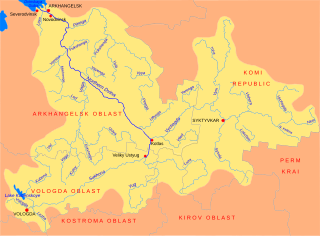
The Mekhrenga is a river in Plesetsky and Kholmogorsky Districts and in the town of Mirny of Arkhangelsk Oblast in Russia. It is a left tributary of the Yemtsa River. It is 231 kilometres (144 mi) long, and the area of its basin 5,080 square kilometres (1,960 sq mi). The principal tributaries of the Mekhrenga are the Shorda (left), the Myagdoma (right), and the Puksa (left).

Pinega Nature Reserve is a nature reserve in the north of Russia, located in Pinezhsky District of Arkhangelsk Oblast, about 150 km due east of the city of Arkhangelsk. The reserve is on the right bank of the Pinega River and on both banks of the Sotka River, the source of the Kuloy River. It was established August 20, 1974. The nature reserve is created to protect the karst landscapes and the coniferous forests (taiga) of the Northern Russia.

Russky Sever National Park is a national park in the north of Russia, located in Kirillovsky District of Vologda Oblast. It was established on March 20, 1992. The name of the park means Russian North in Russian. The park protects natural and cultural landscapes around Kirillo-Belozersky Monastery and Ferapontov Monastery, places of great historical significance.

Darwin Nature Reserve, Darvinsky Zapovednik is a nature reserve in the north of Russia, located in Cherepovetsky District of Vologda Oblast and Breytovsky District of Yaroslavl Oblast, on the shores of the Rybinsk Reservoir of the Volga River. It was established July 18, 1945 to study the effects of raising freshwater level on the environment. It was named after Charles Darwin.

Valdaysky National Park is a national park in the north of Russia, located in Valdaysky, Okulovsky, and Demyansky Districts of Novgorod Oblast. It was established May 17, 1990. Since 2004, the National Park has the status of a UNESCO Biosphere Reserve. Valdaysky National Park, which includes the town of Valday, Lake Valdayskoye, and the northern part of Lake Seliger, is one of the most popular tourist destinations in Central Russia and has well-developed tourist infrastructure.

Rdeysky Nature Reserve, Rdeysky Zapovednik is a nature reserve in the northwest of Russia, located in Poddorsky and Kholmsky Districts of Novgorod Oblast, in the Polist-Lovat Swamp System. The reserve is about 180 km southeast of the city of Pskov. It was established on May 25, 1994. The nature reserve is created to protect the raised bog ecosystems of the Northwestern Russia.

Remdovsky Zakaznik is a federal zakaznik, a nature protected area, in the northwest of Russia, located in Gdovsky and Pskovsky Districts of Pskov Oblast, north of the city of Pskov. It was established in 1985 to protect flora and fauna of the lowlands adjacent to Lake Peipus.

Polistovsky Nature Reserve, Polistovsky Zapovednik is a strict nature reserve in the northwest of Russia, located in Bezhanitsky and Loknyansky Districts of Pskov Oblast, in the Polist-Lovat Swamp System. The reserve is about 120 km southeast of the city of Pskov. It was formally established on May 25, 1994. Previously, it functioned as a zakaznik. The nature reserve is created to protect the raised bog ecosystems of the Northwestern Russia.

Sebezhsky National Park is a national park in the northwest of Russia, located in Sebezhsky District of Pskov Oblast. It was established on January 8, 1996. The national park was created to protect the landscapes of the lake district in the southwest of Pskov Oblast.

Mshinskoye Boloto Zakaznik is a federal zakaznik, a nature protected area, in the northwest of Russia, located in Gatchinsky and Luzhsky Districts of Leningrad Oblast, in the basin of the Luga River. It was established in 1982 to protect the swampy ecosystems including pine forests. From 1994, it is a Ramsar Wetland.
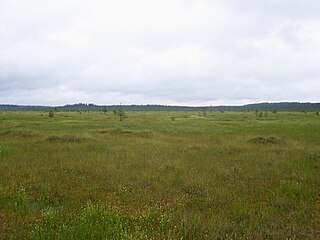
Central Forest Nature Reserve is zapovednik in the north-west of Russia, located in Andreapolsky and Nelidovsky Districts of Tver Oblast, in the upper course of the Mezha River. It was established on 4 May 1930. The nature reserve is created to protect the conifer forest in the upper course of the Western Dvina River. Since 1985, it is classified as UNESCO Biosphere Reserve.







